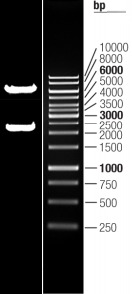BRCA1 (NM_007298) Human Tagged Lenti ORF Clone
CAT#: RC229365L1
- LentiORF®
Lenti-ORF clone of BRCA1 (Myc-DDK-tagged)-Human breast cancer 1, early onset (BRCA1), transcript variant 4
"NM_007298" in other vectors (7)
Specifications
| Product Data | |
| Type | Human Tagged ORF Clone |
| Tag | Myc-DDK |
| Symbol | BRCA1 |
| Synonyms | BRCAI; BRCC1; BROVCA1; FANCS; IRIS; PNCA4; PPP1R53; PSCP; RNF53 |
| Vector | pLenti-C-Myc-DDK |
| E. coli Selection | Chloramphenicol (34 ug/mL) |
| Mammalian Cell Selection | None |
| Sequence Data |
The ORF insert of this clone is exactly the same as(RC229365).
|
| Restriction Sites | SgfI-MluI Cloning Scheme for this gene |
| ACCN | NM_007298 |
| ORF Size | 2277 bp |
| OTI Disclaimer | Due to the inherent nature of this plasmid, standard methods to replicate additional amounts of DNA in E. coli are highly likely to result in mutations and/or rearrangements. Therefore, OriGene does not guarantee the capability to replicate this plasmid DNA. Additional amounts of DNA can be purchased from OriGene with batch-specific, full-sequence verification at a reduced cost. Please contact our customer care team at custsupport@origene.com or by calling 301.340.3188 option 3 for pricing and delivery. The molecular sequence of this clone aligns with the gene accession number as a point of reference only. However, individual transcript sequences of the same gene can differ through naturally occurring variations (e.g. polymorphisms), each with its own valid existence. This clone is substantially in agreement with the reference, but a complete review of all prevailing variants is recommended prior to use. More info |
| OTI Annotation | This clone was engineered to express the complete ORF with an expression tag. Expression varies depending on the nature of the gene. |
| Product Components | The ORF clone is ion-exchange column purified and shipped in a 2D barcoded Matrix tube containing 10ug of transfection-ready, dried plasmid DNA (reconstitute with 100 ul of water). |
| Reconstitution | 1. Centrifuge at 5,000xg for 5min. 2. Carefully open the tube and add 100ul of sterile water to dissolve the DNA. 3. Close the tube and incubate for 10 minutes at room temperature. 4. Briefly vortex the tube and then do a quick spin (less than 5000xg) to concentrate the liquid at the bottom. 5. Store the suspended plasmid at -20°C. The DNA is stable for at least one year from date of shipping when stored at -20°C. |
| Reference Data | |
| RefSeq | NM_007298.3, NP_009229.2 |
| RefSeq ORF | 2280 bp |
| Locus ID | 672 |
| UniProt ID | P38398 |
| Cytogenetics | 17q21.31 |
| Protein Families | Druggable Genome, Transcription Factors |
| Protein Pathways | Ubiquitin mediated proteolysis |
| MW | 84.8 kDa |
| Gene Summary | This gene encodes a 190 kD nuclear phosphoprotein that plays a role in maintaining genomic stability, and it also acts as a tumor suppressor. The BRCA1 gene contains 22 exons spanning about 110 kb of DNA. The encoded protein combines with other tumor suppressors, DNA damage sensors, and signal transducers to form a large multi-subunit protein complex known as the BRCA1-associated genome surveillance complex (BASC). This gene product associates with RNA polymerase II, and through the C-terminal domain, also interacts with histone deacetylase complexes. This protein thus plays a role in transcription, DNA repair of double-stranded breaks, and recombination. Mutations in this gene are responsible for approximately 40% of inherited breast cancers and more than 80% of inherited breast and ovarian cancers. Alternative splicing plays a role in modulating the subcellular localization and physiological function of this gene. Many alternatively spliced transcript variants, some of which are disease-associated mutations, have been described for this gene, but the full-length natures of only some of these variants has been described. A related pseudogene, which is also located on chromosome 17, has been identified. [provided by RefSeq, May 2020] |
Documents
| Product Manuals |
| FAQs |
| SDS |
Resources
Other Versions
| SKU | Description | Size | Price |
|---|---|---|---|
| SC303899 | BRCA1 (untagged)-Human breast cancer 1, early onset (BRCA1), transcript variant 4 |
USD 1,550.00 |
|
| SC328000 | BRCA1 (untagged)-Human breast cancer 1 early onset (BRCA1) transcript variant 4 |
USD 1,550.00 |
|
| RC229365 | BRCA1 (Myc-DDK-tagged)-Human breast cancer 1, early onset (BRCA1), transcript variant 4 |
USD 610.00 |
|
| RG229365 | BRCA1 (GFP-tagged) - Human breast cancer 1, early onset (BRCA1), transcript variant 4 |
USD 670.00 |
|
| RC229365L2 | Lenti-ORF clone of BRCA1 (mGFP-tagged)-Human breast cancer 1, early onset (BRCA1), transcript variant 4 |
USD 810.00 |
|
| RC229365L3 | Lenti-ORF clone of BRCA1 (Myc-DDK-tagged)-Human breast cancer 1, early onset (BRCA1), transcript variant 4 |
USD 810.00 |
|
| RC229365L4 | Lenti-ORF clone of BRCA1 (mGFP-tagged)-Human breast cancer 1, early onset (BRCA1), transcript variant 4 |
USD 810.00 |
{0} Product Review(s)
Be the first one to submit a review






























































































































































































































































 Germany
Germany
 Japan
Japan
 United Kingdom
United Kingdom
 China
China



